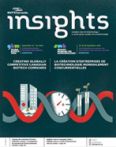What One Tool Is the Most Useful in Guiding Clinical Drug Development?
The title question may seem unrealistic: the scientific depth, medical intricacies, high cost, significant resources, and cross-functional logistics needed to bring a molecule from pre-IND through approval involve head-spinning complexity. Yet seasoned drug developers have found that one tool is central to ensuring a focused path through the labyrinth. That tool is the label.
At this point, you might be asking how on earth the label could serve this role. Isn’t the label a long list of details, printed on tissue-like paper, written at the very end of phase III to include conclusions from pivotal trials? The answer is yes and no. Here is how the label, officially called Physicians’ Prescribing Information (PI), serves as an indispensible compass.
The First PI—It’s Foundational
Many companies use essential label components to drive decisions from pre-IND through approval. Market Planning PI (MPPI) is the first draft of options for claims in the eventual PI, typically including the desired indication statement, efficacy outcomes, key safety features and others. This document is based on an assessment of preclinical results, competitive landscape and clinical outcomes needed for a commercially viable, approvable new drug.
Typically, there is a MPPI for each major market for the drug (e.g. US, EU, Japan), and each includes key label attributes in several sections:
- minimum for registration and break-even commercialization,
- target for success and
- high commercial success.
The reason for dividing into markets is that they vary in regulatory requirements and competitor drugs, and in some cases variations in clinical trials will be required.
For example, the minimum case for US efficacy might be statistically significant superiority vs. placebo at eight weeks in genetically defined subpopulation on a list of outcome measures supporting an indication statement (insert the list of outcome measures, response rates, p-values, and indication wording about acute treatment in the patient population). High commercial success might specify a higher rate of responders, higher average scores on a key efficacy variables, and efficacy in additional subpopulations resulting in an expanded indication. Safety outcomes may be stated in the positive (e.g. rate of discontinuation due to tolerability equal to or less than the standard of care) or negative (e.g. no contraindication for patients with a history of seizures). As a drug achieves actual clinical results and new competitors enter the market, the MPPI is modified.
For many companies, the Market Planning PI serves as an ongoing summary guide to development goals and unfolding commercial viability of the asset.
The PI for Discussions with Regulators
While the MPPI is for internal use only, the Targeted Product Profile facilitates discussions with regulatory authorities. Although FDA does not require the TPP, it is widely used, and FDA offers detailed guidance and a template. The purpose of a TPP is to provide content categories and format for discussions between a sponsor and FDA. The TPP embodies the notion of beginning with the end, the approved PI, in mind.
FDA’s TPP template is divided into the 17 sections required for the final, approved PI. In the left column of the TPP, sponsors enter target PI language and in the right column they enter studies intended to support the language. This approach makes all plans clear and specific. Although the discussions based on the TPP are not binding to either party, the TPP is enormously helpful in enabling specific feedback from the agency. Many companies would not consider a meeting with the FDA or other agencies without one.
The Safety PI for Development
The Development Core Safety Information document is also not required by FDA or other agencies but is used by many pharmas. As early clinical trial results come in, the DCSI captures adverse reactions and other safety information and organizes them into PI categories: contraindications, special warnings and precautions, interactions with other medicines, use in pregnancy and lactation, adverse reactions, overdose, and drug abuse and dependence. The DCSI is a living document that can be included as an appendix in the Investigator’s Brochure and used as a guide for expectedness for safety reporting to regulatory authorities during development. The DCSI in phase III, before all pivotal results are known, becomes the first draft of the safety sections of the PI, which will be revised for submission.
The PI Negotiation Guide
The final stage of development of the PI for submission deserves a separate discussion. Suffice it to say that the effort may be substantial and will involve multiple functional experts who worked on the drug. The FDA and other agencies have regulations and many guidance documents to assist.
Typically, drug development teams take a breather after the final push to complete the submission, and then they develop a guide for negotiating the PI with regulatory authorities. Psychologically, this process is tough. After years of work to bring a drug this far, the team must transform themselves into skeptics or bring in outsiders to play that role. At minimum the team must be prepared for all matter of challenges to their submitted PI.
A thorough negotiation document includes all submitted PI wording. For each statement or PI section, the document identifies objections regulatory reviewers may raise, likelihood of each objection, impact of agency requested wording, and counter proposals to the agency request in priority order. This is an exceedingly confidential document distributed on a limited basis.
Experience indicates that only about 20 percent of the objections in the negotiation guide will be raised (and others you did not anticipate will be made). However, having a thoughtful strategy to deal with the 20 percent is invaluable during the intensity of real time PI negotiations.
The Prize at the End
Achieving an approval is one of the high points of any company’s development efforts. When an organization is knee deep in the complexities of pre-IND or early clinical work, it is challenging to think about the specifics of that prize which may be given in four to seven years. Yet experienced drug developers know what is at stake: the PI tells prescribers how to use a drug safely and effectively for which patient populations in what ways and therefore can have life and death impact. The PI also governs everything a sales force and marketing materials can claim about a drug. The approved PI is the leading influence on whether a drug is highly competitive, competitive, or noncompetitive on the market. And when regulators take action on a submission, they approve only two intertwined things: marketing of a drug with a particular PI. It is in every stakeholder’s interest to use the PI to drive development forward using best practice tools.



